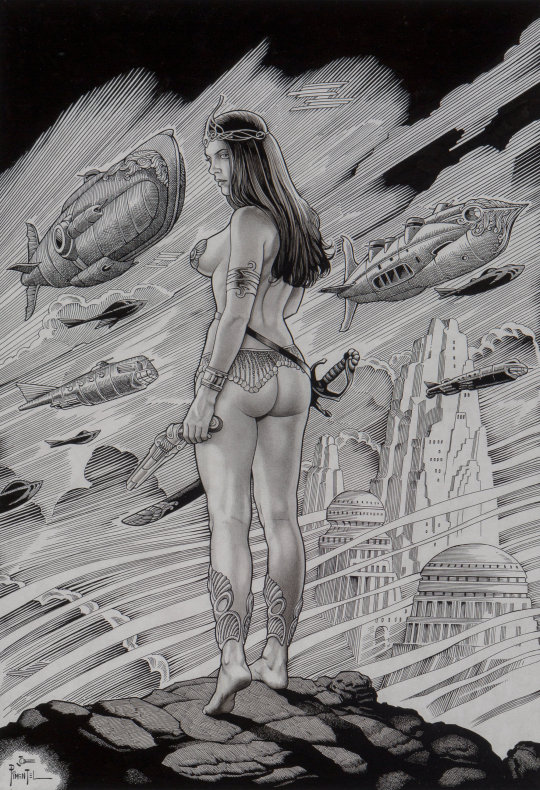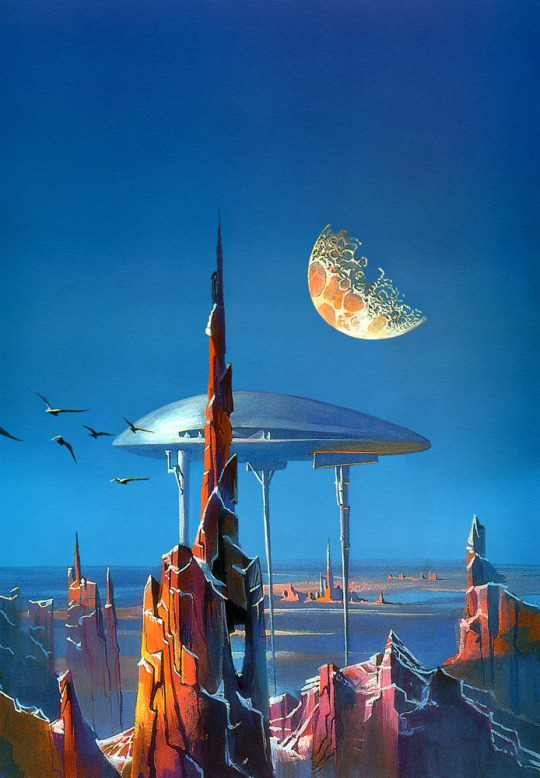#MoonZeroTwo
Explore tagged Tumblr posts
Photo

O Pioneer! - Bob Eggleton https://ift.tt/2MZ4hmY
67 notes
·
View notes
Photo

I love #spaceagefashion and it’s glib outmoded futuristic though rather mild exploration of women. They’re from both sides of the #ironcurtain Making them comparatively very interesting. I’ve just uploaded this cache of original press photos from my latest catalogue to my website. #catherineschell #jacquesheim #emmanuellekhanh #cosmonauties #keystone #agip #dalmas #moonzerotwo https://www.instagram.com/p/BsoixVcljk3/?utm_source=ig_tumblr_share&igshid=rz6defeo2ytp
#spaceagefashion#ironcurtain#catherineschell#jacquesheim#emmanuellekhanh#cosmonauties#keystone#agip#dalmas#moonzerotwo
0 notes
Note
Me again! Realised I left off a part of that ask of many asks (!!!): if a planet is tidally locked to its star but has two other bodies orbiting it, would that affect climates at all? i.e. provide light+heat to the darker side, etc etc? Sorry for so many asks!
You keep asking, we’ll keep answering. :-)In general, orbiting moons wont have an effect on the climate of their primary. The light they reflect from the sun won’t have much effect on the weather. The Moon of Earth is about 1/400000th as bright as the Sun, so the amount of extra energy the Moon dumps into Earth is negligible.What orbiting moons can change is the planet’s ecosystem. The Moon has an incredible effect on Earth’s wildlife through creating tides to making the night much less dark than it would. Many animals have parts of their life cycles influenced by the Moon. Multiple moons might have multiple cycles, with different species tagging off of one moon or the other’s cycle.
Also, a moon can effect the tectonic movement of it’s primaries. Flexing the surface of a planet can cause more and/or stronger earthquakes and volcanoes.
In general, the closer a moon orbits it’s planet and the more massive the moon is, the more effect it will have. Bigger moon effects tectonics and tides, brighter moon effects plants and animals.
21 notes
·
View notes
Photo
♬♪Flowing with the Earthballon crashing in the Moon♬♪

Earth - Love It or Lose It - Jim Warren
252 notes
·
View notes
Text
Huzzah! 200 Followers!
YAAAY! Sending out a big THANK YOU since I just reached 200 followers! A special shout out to my very first follower, @ramblingnic, and my latest, @moonzerotwo. Plus long-time regulars @shadeofjeremy, @whynotpretty-and-weird, @benicioqueen, @cameronscurrie, and @mrs-3 (and I apologize because I PROBABLY FORGOT SOMEONE). *does a dance*
12 notes
·
View notes
Link
0 notes
Photo

70sscifiart via Twitter: moonzerotwo: Chronicles of the Lensman - John C. Berkey https://t.co/kS0ExRdEOe https://t.co/V18WDlsIcg http://twitter.com/70sscifiart/status/862564053805404160
0 notes
Link
0 notes
Link
via Twitter https://twitter.com/jaypeg
0 notes
Link
0 notes
Photo

A Choice of Gods - Vincent Di Fate https://ift.tt/2ob35U5
53 notes
·
View notes
Photo

moonzerotwo: Attention All Planets of the Solar Federation -... http://ift.tt/2o0obPU from @humanoidhistory
0 notes
Note
Love the blog, thanks for your work here! I have a fantasy world with 4 moons. A is the largest, then B C and D being the smallest. A is Geosynchronous, over an ocean, and D orbits around A. While B and C have "regular" moon orbits around the planet. Would A and D be possible? And besides complex tides, how else could this set up affect the planet?
D is plausible within certain parameters, but wouldn’t be very likely. Moon A would have to be fairly big, and moon D would have to be very very small and orbit around A at a very very close distance,
Moon D would have to orbit around moon A closer than its Hill Sphere, and higher that it’s Roche Limit. These distances would depend on the mass of the planet, the mass of moon A, and the mass of moon D. Without knowing specifics, I’d have to say that both A and D would have to be fairly small (at least compared to out Earth’s Moon) assuming your planet is fairly much Earth sized.
So, lets assume that your planet P is the same size and mass as Earth. We’ll set moon A as the equivalent of the asteroid Ceres. That’s about 475 km across - a nice size moon without being obnoxious. Moon D would have to orbit around A less than about 1300 km or it would be pulled out of orbit by your planet’s gravity. Moon D would also have to orbit around A higher that about 1150 km, or the gravity of moon A would tear moon D apart.Moon D is threading the needle between being pulled away and being pulled in and being destroyed.

So, yeah, it’s possible, but that situation is going to be very unstable, and after a few hundred thousand years, Moon D will either be pulled into an orbit around your planet or be pulled into Moon A and break up into a ring around moon A.
17 notes
·
View notes
Photo
http://www.juangimenez.com/galeria/index.html

#lambentburg#futurism#architecture#occult#decay#design#nostalgia#virtual#natural#cinema#couture#animation#technology#artefact#metropolis#moonzerotwo
870 notes
·
View notes
Photo

Deja Thoris - Joe Pimentel https://ift.tt/35F4kLd
26 notes
·
View notes
Photo

A Sense of Wonder - Bruce Pennington https://ift.tt/3285tsF
24 notes
·
View notes